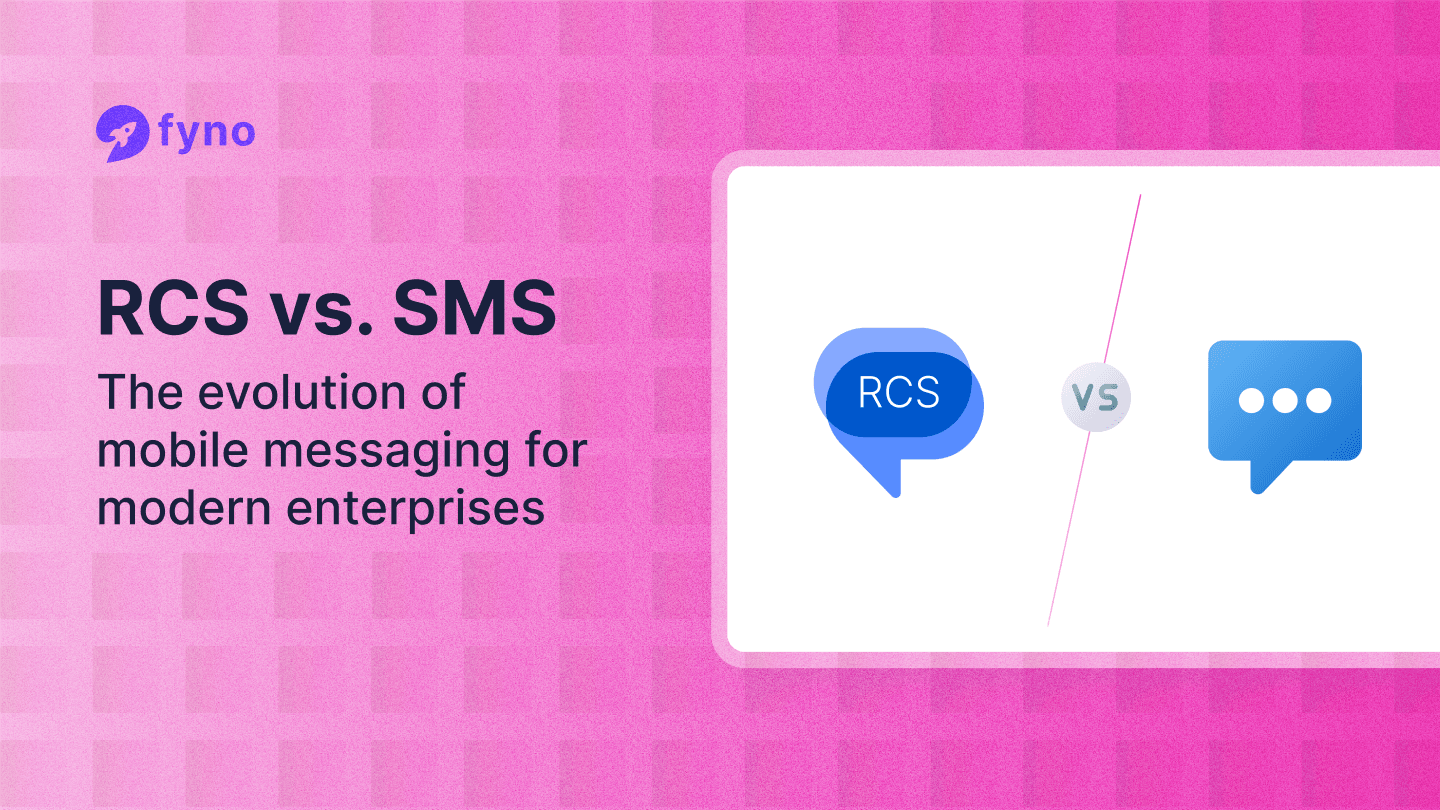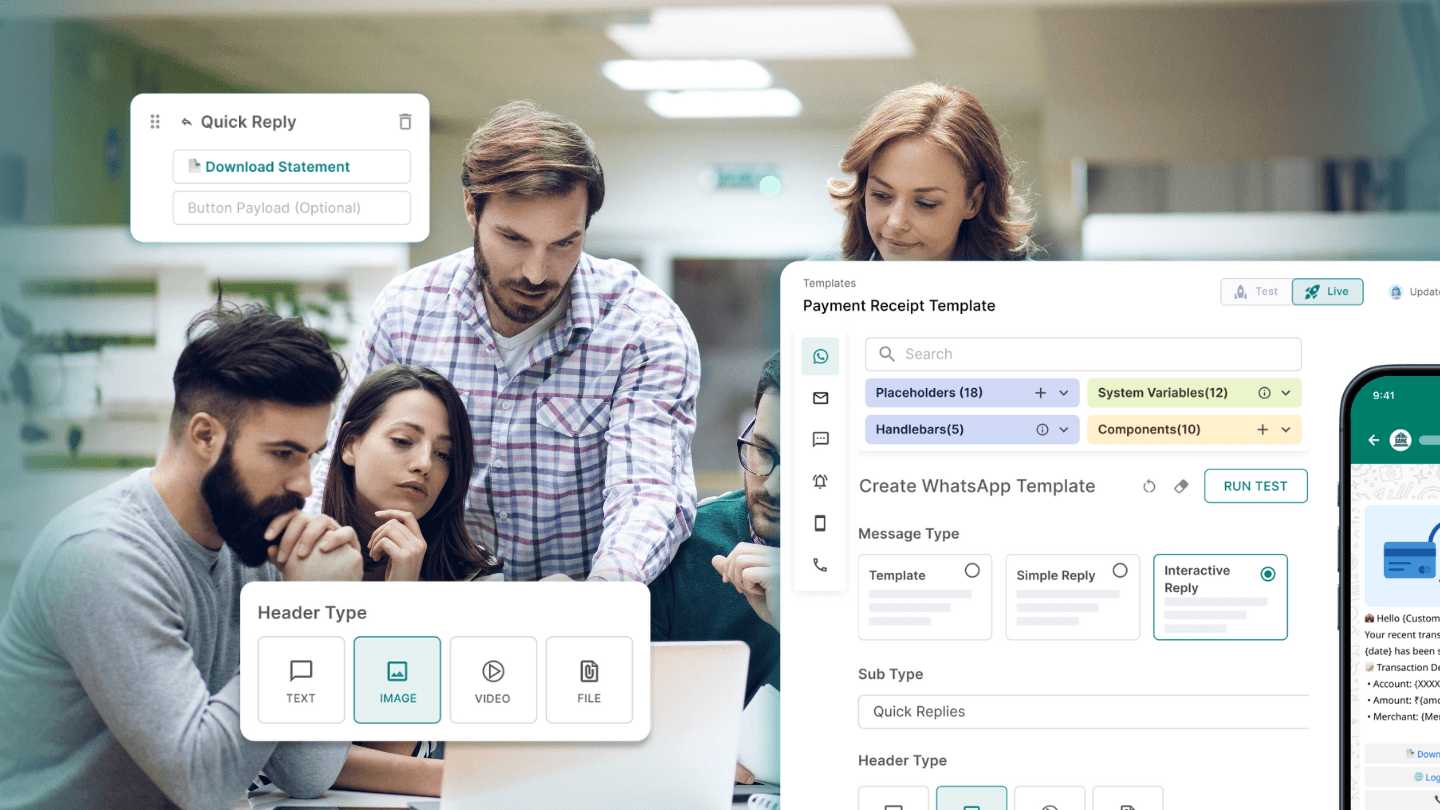At this point, you've probably heard the buzz about RCS. Or maybe you've been caught in the crossfire of the great “blue bubble vs. green bubble” debate. If not, let me do a quick recap.
RCS, or Rich Communication Services, burst onto the scene as Google's answer to the ageing SMS.
Think of it this way: SMS is like that reliable old flip phone you keep in a drawer 'just in case.' It always works, but it's pretty basic. RCS? It's the shiny new smartphone that does everything but make your coffee (though we hear that feature is coming in the next update). It's got the reliability of SMS but with the added pizzazz of read receipts, typing indicators, and the ability to send that perfect GIF reaction. And the best part? You don't need to download yet another instant messenger app to use it!
But here's the million-dollar question: What would be the impact of RCS in the high-stakes world of business communication? Can it truly win over the SMS? Or are we just chasing the next shiny object?
In this blog post, let’s dive deep into the RCS vs. SMS debate.
We'll cut through the tech jargon, explore real-world applications, and help you decide whether it's time to jump on the RCS bandwagon or stick with SMS. By the end, you'll have a clear roadmap to plan the future of your business communication strategy.

The evolution of mobile messaging
The birth of SMS
Picture this: It's the 1990s. The internet is in its infancy, smartphones don't exist, and the height of mobile technology is a brick-sized cellphone with a tiny monochrome screen. In this world, SMS makes its debut, and it's nothing short of revolutionary.
SMS, or Short Message Service, burst onto the scene, introducing the world to the concept of instant text communication. For the first time, people could send short, text messages directly to another person's phone – no phone call required. It was quick, it was quiet, and it changed the way we communicate, forever.
Whether you were there to experience the dawn of SMS or you've grown up in a world where texting is as natural as breathing, it's difficult to overstate the impact of this technology. Simple, direct, and universally accessible, SMS quickly became the go-to method for quick communications, laying the groundwork for the messaging-centric world we live in today.
Why businesses fell in love with SMS?
As SMS gained widespread adoption among consumers, businesses quickly recognized its potential as a powerful communication tool. Here's why SMS became a darling of the business world:
- Unparalleled reach: With SMS, businesses could reach almost anyone with a mobile phone, regardless of the device's capabilities or internet connectivity.
- High open rates: SMS boasts impressive open rates of up to 98%, far surpassing email and other forms of digital communication.
- Instant readability: Messages are typically read within three minutes of receipt, making SMS ideal for time-sensitive information.
- Cost-effective: Compared to traditional advertising channels, SMS offered a budget-friendly way to reach customers directly.
- Versatility: From appointment reminders to One-Time Passwords (OTPs), SMS could be used for a wide range of business communications.
- Simplicity: With its 160-character limit, SMS forced businesses to craft clear, concise messages – a boon in an age of information overload.
The need for RCS
Despite its simplicity and widespread adoption, SMS was starting to feel like a relic in the age of smartphones. It came with many limitations, including a lack of business communication security features like encryption.
RCS or (Rich Communication Services) was introduced to solve these problems. It was the much-needed, much-awaited upgrade for the SMS. RCS is designed to deliver what the users want. This includes:
- End-to-end encryption: All the messages sent and received secure and private, which is one of the major upgrades when compared to SMS.
- Rich media support : Users can send high-quality photos, videos, and files directly through their messaging app.
- Typing indicators: Users can see when the other person is typing a response, a feature users love while having an interesting conversation with a friend or a critical conversation with customer support.
- Read receipts: RCS indicates when your message has been read.
- Group chats: Users can have conversations with multiple people within a group - something that wasn’t possible with SMS.
- Video calls: RCS supports also video calls directly from the messaging app.
- Location sharing: Users can share their location with others right from their messaging app, as they do on WhatsApp.
- In-app payments: Users can send or request money within the chat.
- Cross-app connectivity: Link to other apps like maps or browsers from within messages.
- One-tap replies: Users can respond quickly with predefined messages or reactions.
These features represent RCS’s significant leap forward from traditional SMS, addressing the evolving needs of users in an increasingly connected world.
RCS vs. SMS: A detailed comparison
Feature | RCS | SMS |
| Message Content | Supports rich media, including high-resolution images, videos, and audio messages | Limited to 160 characters of plain text |
| Character Limit | Up to 8,000 characters per message | 160 characters per message, longer messages split into multiple texts |
| Media Capabilities | Rich media support (images, videos, GIFs) | No native support for media |
| Delivery Confirmations | Offers delivery confirmations | No built-in delivery confirmations |
| Read Receipts | Available, enhancing communication transparency | Not available |
| Typing Indicators | Shows when the other person is typing | Not available |
| Group Chat | Advanced features with admin controls and seamless media sharing | Limited capabilities, often carrier-dependent |
| Business Messaging | Verified sender profiles, custom branding, and rich card layouts | Limited branding options, typically just the sender's name or number |
| Security | End-to-end encryption available for improved security | Basic security with limited encryption |
| Internet Dependency | Requires data connection, can fall back to SMS when offline | Works without internet connection. Uses cellular networks |
| Device Compatibility | Growing compatibility, but not yet universal | Universal compatibility. Works on all mobile devices |
| Carrier Compatibility | Requires support from both device and carrier | Supported by all carriers |
| Cost for Businesses | Potentially higher cost per message, but with increased engagement rates | Generally lower cost per message, but can add up with high volume |
| Interactivity | Supports interactive buttons and suggested replies | No interactive elements |
| Branding | Rich branding opportunities with logos and brand colors | Limited to sender name/number |
Practical applications: When to use RCS vs. SMS
SMS: Scenarios where it remains the top choice
- Critical alerts and notifications
- Wide-reaching campaigns requiring universal delivery
- Simple, text-based communications
- Situations where internet connectivity may be limited
RCS: Leveraging advanced features for enhanced engagement
- Product showcases with high-quality images and videos
- Interactive customer support conversations
- Appointment booking and management
- Surveys and feedback collection
The future landscape of mobile messaging
A lot of businesses have begun to see the value of RCS in their customer engagement strategy. With more carriers and device manufacturers adopting RCS, it is expected to become the new standard in messaging in the next couple of years. Businesses who currently rely on SMS heavily, should prepare for this shift to stay ahead of the curve.
The potential phase-out of SMS
While SMS isn't disappearing overnight, its role may diminish when RCS becomes more prevalent.
However, SMS will likely remain a fallback option for the foreseeable future.
Integration with AI, chatbots, and emerging technologies
The rich features of RCS open up new possibilities for integration with AI-powered chatbots, voice assistants, and other emerging technologies, creating more sophisticated and personalized customer interactions.
Implementing a dual RCS + SMS strategy for your business
We’re not suggesting you ditch SMS and completely switch over to RCS. The right thing to do is to create a rich, powerful, and intuitive messaging experience for your customers using a combination of SMS and RCS.
Assess your communication needs
Go back to the drawing board and take another look at your target audience, their age group, their preferences, and the type of message content that works for them. On the other hand, go through various customer scenarios where you use SMS and see how RCS improves the experience by 3X or 5X. This will give you a clear understanding of when to use SMS and when to use RCS.
Best practices for implementing RCS as part of your messaging strategy
- Come up with a list of scenarios or a customer segment where RCS would work best.
- Start with a pilot program to test engagement and ROI.
- Play around with various features, including building a branded theme, adding interactive features, and sending dynamic messages.
- Understand the usefulness of your RCS strategy through user interviews or feedback surveys.
- Build workflows to switch to SMS when RCS isn’t working or if messages are not getting delivered.
Closely monitor the performance of your RCS campaigns and analyze how much value they have delivered compared to your current SMS strategies. If you see a clear win, you can start rolling out RCS for other scenarios in a phased manner.
Maintaining SMS as a reliable fallback option
While embracing RCS, don't neglect your SMS strategy. Maintain it as a reliable fallback to ensure all customers receive your messages, regardless of their device capabilities.
Fyno: Streamlines RCS and SMS integration for optimal communication
Fyno offers a comprehensive solution for businesses looking to leverage both RCS and SMS in their communication strategies. Our platform provides a single interface to manage all your messaging needs.
Benefits of managing RCS and SMS through a single interface
- Simplified workflow for creating and sending messages
- Consistent branding and messaging across both SMS and RCS channels
- Unified analytics for better insights and decision-making
- Seamless fallback from RCS to SMS when needed
Advanced features for message delivery optimization
Fyno's intelligent routing ensures your messages are delivered through the most effective channel for each recipient, maximizing engagement and deliverability.
Analytics and insights for performance tracking
Our platform provides detailed analytics on message performance, helping you refine your communication strategy for better results.
Powerful no-code workflow builder
Fyno’s powerful workflow builder lets you build complex messaging experiences using both SMS and RCS. You can build smart workflows that can trigger RCS based on customer type, location, and preferences. You can also add fallback protocols to switch to SMS in case of message failure.
Optimize workflows without touching your codebase
Fyno’s plug-and-play API endpoints make it easy for you and your team to optimize RCS workflows without worrying about resource allocation, sprint planning, code changes and deployments. All you have to do is log into Fyno and make changes to the workflow - it can be anything from changing a messaging template to switching your RCS provider, and we’ll take care of the rest.
Step into the future of business messaging, one message at a time
Remember, the world of business communication is ever-evolving. By embracing both RCS and SMS, and leveraging a unified platform like Fyno, you're not just keeping up – you're staying ahead of the curve.
So, what are you thinking? Are you ready to transform your customer communications with RCS? If you’re thinking yes, talk to us to understand how we can help you.


